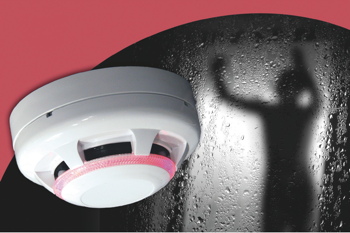Alarmed about steam?

Fire detectors in accommodation with en suite facilities, such as hotels and student halls of residence, can be susceptible to false alarms caused by steam. It is a real problem, for which Lee James of Nittan Europe discusses the problems and how to overcome them.
An automatic fire detection (AFD) and alarm system can vary from small simple systems with one or two manual call points and sounders to systems that incorporate a large number of automatic fire detectors, manual call points and sounders connected to numerous intercommunicating control and indicating panels.
An appropriate AFD system — dictated by British Standard BS 5839-1 which covers the design, installation, commissioning and maintenance of systems in both new-build and existing non-domestic premises — will warn everyone in the building of a potential fire at the earliest opportunity so that they can evacuate it, and also alert the fire brigade.
AFD systems save lives, there’s no doubt about it. However, the issue of false alarms in such systems is a major problem.
False alarms which have been generated by the fire-detection system, but not in response to an actual fire, are one of the biggest issues faced by those working in the fire industry. False alarms cost the UK in excess of £1 billion every year.
In hotels and other places where there are significant numbers of people sleeping in rooms with en-suite facilities, steam is one of the major causes of false alarms. They must have an alarm in each bedroom, usually placed close to the main door to protect the escape route — but this is also where you most often find the bathroom door and a major source of steam.
Generally speaking, the infra-red scattered-light technology currently used for commercial smoke detectors is unable to distinguish between larger particles like steam or dust and particles generated by combustion (fire).
One solution is to move the detector further away from the bathroom, but this could compromise safety and there is the cost associated with moving devices and cables and redecorating afterwards.
A further option is to use a multi-sensor that combines two sensing elements, usually optical and heat. It interprets the signals from both sensors to get a better understanding of what’s really happening in the immediate environment. There is a quick response to both slow-smouldering and fast-flaming fires but with greater immunity to false alarms. It’s a better option, but ‘greater immunity’ may not be good enough.
Another detector-based solution uses the same ‘two-is-better-than-one’ principle, but in a different way. Dual optical alarms use a single sensor type — optical — which ‘looks’ for smoke using a scattered light beam in the sensing chamber. However, instead of just using infra-red light, they also employ blue LEDs to provide a more accurate measurement of particles within the chamber. By calculating the ratio of these light sources, which operate at different wavelengths, the detector can determine the particle size and thus distinguish between smoke and non-combustion products such as steam and dust. This technology is incorporated into Nittan’s Evolution EV-DP and EVC-DP detectors. It reduces false alarms caused by steam, but the detector remains sensitive to combustion products to generate an alarm.

The University of East Anglia’s (UEA) student accommodation is a good example of the issue of false alarms caused by steam. UEA was experiencing around 20 false alarms every week caused by steam escaping from the bathrooms. Each alarm event has to be checked and verified by security personnel before Fire & Rescue Services will attend. A reduction in false alarms was therefore not just convenient, but also had significant cost and time benefits.
Greg Smith, director of Global Fire Services, which was brought in by UEA to address the issue, explains further: ‘Originally the plan was to relocate the existing detectors further away from the bathrooms. Whilst this would provide the same level of fire protection, it would be quite a costly solution as it would not only involve moving the devices and cables, but also redecorating afterwards to cover up where the alarms had been previously. We were also concerned that the steam would affect these devices in the new location.
‘As the existing alarms were coming to the end of their lives anyway, we swapped them to Nittan’s EV-DP smoke detectors which easily cope with steam.’
12 months on and there have been no false alarms due to steam.
The Cliff Hotel & Spa in Cardigan, West Wales experienced similar problems. The hotel had been experiencing false alarms, primarily caused by steam escaping from the en-suite bathrooms. The installer, Fire and Security Alarms Ltd, was familiar with the problem and replaced the existing alarm system with a Nittan Evolution system including over 200 EV-DP dual optical smoke detectors. The new alarms have prevented further false-alarm issues for the hotel.
Fire detection and alarm systems are absolutely essential, but no one should have to put up with false alarms. If your fire detection system is causing disruption as a result of false alarms, take action. False alarms, especially from steam, don’t have to be a headache.
Lee James is general manager — sales and marketing, Nittan Europe Ltd







